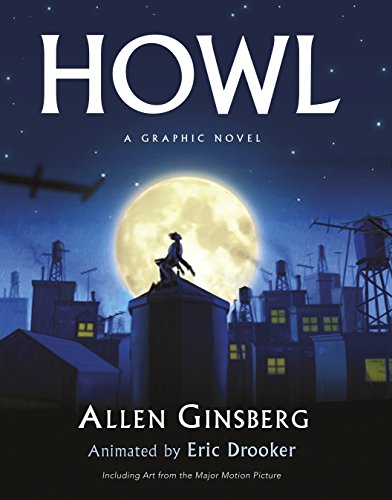Items related to Howl: A Graphic Novel. by Eric Drooker

Beat movement icon and visionary poet, Allen Ginsberg was one of the most influential poets of the twentieth century, and broke boundaries with his fearless, pyrotechnic verse. The apocalyptic 'Howl', originally written as a performance piece, became the subject of an obscenity trial when it was first published in 1956. It is considered to be one of the defining works of the Beat Generation, standing alongside that of Burroughs, Kerouac, and Corso. In it, Ginsberg attacks what he saw as the destructive forces of materialism and conformity in the United States at the time, and takes on issues of sex, drugs and race, simultaneously creating what would become the poetic anthem for US counterculture.
"synopsis" may belong to another edition of this title.
From the Author:
Introduction by Eric DrookerFirst time I hung with Allen Ginsberg, one long hot summer night in 1988, the streets were hopping mad. Riot cops on horseback were slowly moving in our direction, enforcing a midnight curfew, but the chanting crowd refused to leave Tompkins Square Park--a refuge for punks, homeless, squatters, artists and other riffraff who'd been "keeping real estate prices down" on Manhattan's Lower East Side. When the police charged, swinging clubs, we lost each other in the crowd. When I bumped into Allen a year later, and he realized that I was the artist who'd created so many of the street posters in the neighborhood, he admitted that he'd been peeling them off brick walls and lampposts, and collecting them at home. He suggested we do a poster together. Over time, we collaborated on numerous projects, bouncing his words off my pictures. Our book, Illuminated Poems, became an underground classic, and ultimately caught the attention of filmmakers Rob Epstein and Jeffrey Friedman. They were just starting to direct a feature film about Allen's early poem "Howl" and it's historical significance--with Hollywood actors playing Ginsberg and his friends, Jack Kerouac and Neil Cassady. When they approached me with the ingenious idea of animating "Howl," I thought they were nuts and said "sure, let's animate Dante's Inferno while we're at it!" Then they told me I'd work with a team of studio animators who would bring my pictures to life . . . how could I say no? Last time I hung with Allen Ginsberg was on a cold winter night three months before he died. Over the phone he'd invited me to join him for dinner at his favorite Chinese restaurant. As usual, we discussed current events, politics, and eventually got onto the subject of art. Allen brought up the painting The Triumph of Death by the 16th century master, Pieter Bruegel the Elder. "Have you ever seen it . . . in real life?" he asked. "No . . . not yet. Where is it?" I asked. "It's in Spain, in the Prado Museum. It's enormous and fucking terrifying!" After supper we went up to his apartment, where Allen was in the process of getting rid of things he no longer needed. "Hey Eric, you want this jacket? It looks about your size." He handed me a crimson-red blazer jacket. I tried it on. . . . "Good fit" he said, "now it's yours."
From the Inside Flap:
"In publishing 'Howl,' I was curious to leave behind after my generation an emotional time bomb that would continue exploding in U.S. consciousness, in case our military-industrial-nationalist complex solidified into a repressive police bureaucracy.""I was also curious to see how [Eric Drooker] would interpret my work. And I thought that with today's lowered attention span TV consciousness, this would be a kind of updating of the presentation of my work . . . To me, the megalopolis landscapes are the most interesting--that gigantic skyscraper vision. He really captured that sense of Moloch I was going for in the second section of 'Howl'--'Moloch whose buildings are judgment!'""I began collecting Drooker's posters soon after overcoming shock, seeing in contemporary images the same dangerous class conflict I'd remembered from childhood, pre-Hitler block print wordless novels . . . the solitary artist dwarfed by the canyons of a Wall Street megalopolis lay shadowed behind my own vision of Moloch. . . . What 'shocked' me in Drooker's scratchboard prints was his graphic illustration of economic crisis similar to Weimar-American 1930's Depressions. . . . Drooker illustrated the city's infrastructural stress, housing decay, homelessness, garbage-hunger and bitter suffering of marginalized families, Blacks and youth, with such vivid detail that the authoritarian reality horror of our contemporary dog-eat-dog Malthusian technoeconomic class-war became immediately visible. . . . As I'd followed his work over a decade, I was flattered that so radical an artist of later generations found the body of my poetry still relevant, even inspiring. Our paths crossed often . . . " - ALLEN GINSBERG
"About this title" may belong to another edition of this title.
- PublisherPenguin Group
- Publication date2010
- ISBN 10 0141195703
- ISBN 13 9780141195704
- BindingPaperback
- Number of pages224
- IllustratorEric Drooker
- Rating
Buy New
Learn more about this copy
US$ 67.27
Shipping:
US$ 4.00
Within U.S.A.
Top Search Results from the AbeBooks Marketplace
Howl: A Graphic Novel. by Eric Drooker
Published by
Penguin Group
(2010)
ISBN 10: 0141195703
ISBN 13: 9780141195704
New
Paperback
Quantity: 1
Seller:
Rating
Book Description Paperback. Condition: new. Eric Drooker (illustrator). New. Fast Shipping and good customer service. Seller Inventory # Holz_New_0141195703
Buy New
US$ 67.27
Convert currency

